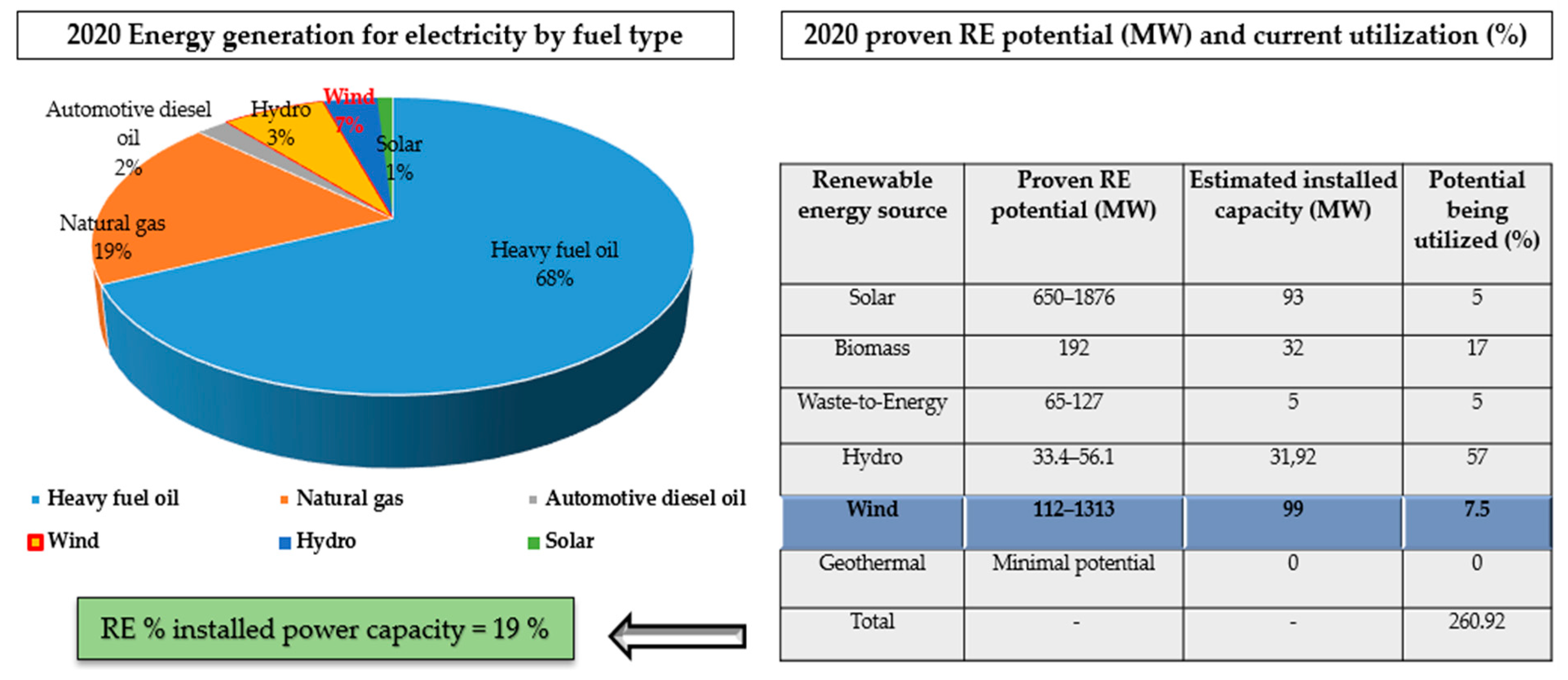Spatial Mapping of Jamaica’s High-Resolution Wind Atlas: An Environmental-Sociotechnical Account
Abstract
1. Introduction
2. Materials and Methods
2.1. Data Gathering and Selection
2.2. Resource Assessment
2.3. Geoprocessing
2.4. Wind Resources Analysis
Wind Speed Selection
2.5. Developing Suitability for Environmental-Sociotechnical Atlas
2.5.1. Slope
2.5.2. Elevation
2.5.3. Wind Power Calculation
2.5.4. Number of Wind Turbines and Spacing
3. Results and Discussion
3.1. Restricted and Unrestricted Zones
3.2. Wind Resource Mapping
3.3. Socioenvironmental Technical Atlases
3.4. Practical Application
4. Conclusions
5. Limitations
Author Contributions
Funding
Institutional Review Board Statement
Informed Consent Statement
Data Availability Statement
Acknowledgments
Conflicts of Interest
References
- The United States Environmental Protection Agency. Renewable Energy Fact Sheet: Wind Turbines. 2013. Available online: https://www.epa.gov/sites/default/files/2019-08/documents/wind_turbines_fact_sheet_p100il8k.pdf (accessed on 15 April 2022).
- The World Wind Energy Association. SUSTAINABILITY and due diligence GUIDELINES. 2004. Available online: http://www.wind-works.org/articles/WWEA_Sust_Guide.pdf (accessed on 19 May 2022).
- Cross, D.T. Placing Wind Farms too Close Together Isn’t a Good Idea. 2018. Available online: https://www.sustainability-times.com/low-carbon-energy/placing-wind-farms-too-close-together-isnt-a-good-idea/#:~:text=Upwind%20farms%20generate%20%E2%80%9Cwake%20effects,researchers%20in%20the%20United%20States (accessed on 4 April 2022).
- Xu, J.; Liu, T. Technological paradigm-based approaches towards challenges and policy shifts for sustainable wind energy development. Energy Policy 2020, 142, 111538. [Google Scholar] [CrossRef]
- Wind Power. 2021. Available online: https://www.iea.org/reports/wind-power (accessed on 4 April 2022).
- Wright, R.M. Wind energy development in the Caribbean. Renew. Energy 2001, 24, 439–444. Available online: https://www.sciencedirect.com/science/article/pii/S096014810100026X?casa_token=e8AwWPFSDo4AAAAA:8jFuHRh7v8y-ATZaJNsAZNKFdVg3YlPYRImXIcpNjrk6pq77djzjvnQZDSm7By2FkT2Pl4l3 (accessed on 4 March 2022). [CrossRef]
- Costoya, X.; DeCastro, M.; Santos, F.; Sousa, M.C.; Gómez-Gesteira, M. Projections of wind energy resources in the Caribbean for the 21st century. Energy 2019, 178, 356–367. Available online: https://www.sciencedirect.com/science/article/pii/S0360544219307546?casa_token=PriUKy8t5zEAAAAA:coGQW_LGTuML4dg1V5SclHvwjSDLhcDjIev8wewD-PQwwJWGKgOqYeUdSfzqJ29oFgyEXO2h (accessed on 22 March 2022). [CrossRef]
- wei Zheng, C.; Pan, J. Assessment of the global ocean wind energy resource. Renew. Sustain. Energy Rev. 2014, 33, 382–391. [Google Scholar] [CrossRef]
- Energy Division, Ministry of Science Energy and Technology. 2017 Energy Report Card Jamaica. 2018. Available online: https://europa.eu (accessed on 2 February 2022).
- United States Department of Energy. Energy Transitions Initiatives: Jamaica Energy Snapshot. 2020. Available online: Energy.gov/sites/default/files/2020/09/f79/ETI-Energy-Snapshot-Jamaica_FY20.pdf (accessed on 18 February 2022).
- Ochs, A.; Konold, M.; Auth, K.; Musolino, E.; Killeen, P. Caribbean Sustainable Energy Roadmap and Strategy (C-SERMS); Worldwatch Institute: Washington, DC, USA, 2015; Volume 29, Available online: http://www.worldwatch.org/system/files/C-SERMS_Baseline_10 (accessed on 13 February 2022).
- Richards, D.; Yabar, H. Potential of Renewable Energy in Jamaica’s Power Sector: Feasibility Analysis of Biogas Production for Electricity Generation. Sustainability 2022, 14, 6457. [Google Scholar] [CrossRef]
- THE WIND POWER Jamaica Production Capacity. 2019. Wind Energy Marketing Intelligence. Available online: https://www.thewindpower.net/country_en_30_jamaica.php (accessed on 10 April 2022).
- Bailey, K.A.; Muir, D.D.; Chambers, T. Offshore Wind Farm as Jamaica’s Possible Primary Source of Renewable Energy. Arts Sci. Technol. 2013, 6, 34. [Google Scholar]
- Chen, A.A.; Daniel, A.R.; Daniel, S.T.; Gray, C.R. Wind power in Jamaica. Sol. Energy 1990, 44, 355–365. [Google Scholar] [CrossRef]
- Chen, A.A.; Stephens, A.J.; Koon, R.K.; Ashtine, M.; Koon, K.M.K. Pathways to climate change mitigation and stable energy by 100% renewable for a small island: Jamaica as an example. Renew. Sustain. Energy Rev. 2020, 121, 109671. [Google Scholar] [CrossRef]
- Romanian Agency for International Development Cooperation—RoAid. A Review of the Jamaican Energy Sector and Development Opportunities. 2019. Available online: https://ridgeline-industrial.ro/Studiu-fezabilitate-Jamaica-V4-15-Mar-2019.pdf (accessed on 13 February 2022).
- Global Wind Atlas. 2022. Available online: https://globalwindatlas.info/ (accessed on 2 January 2022).
- Planning Institute of Jamaica. Vision 2030 Jamaica: National Development Plan; PIOJ: Kingston, Jamaica, 2009. [Google Scholar]
- Ministry of Energy and Mining. National Renewable Energy Policy (2009–2030). 2010. Available online: https://www.mset.gov.jm/sites/default/files/pdf/Draft%20Renewable%20Energy%20Policy.pdf (accessed on 9 March 2022).
- Jamaica Information Service, Office of the Prime Minister, Jamaica to Increase Renewables Target to 50%—PM Holness. 2018. Available online: https://jis.gov.jm/jamaica-to-increase-renewables-target-to-50-pm-holness/ (accessed on 13 November 2018).
- Ministry of Science, Energy, and Technology. JAMAICA—Regulatory Indicators for Sustainable Energy. “JAMAICA ENERGY INVESTOR GUIDE”. 2017. Available online: https://rise.esmap.org/data/files/library/jamaica/Renewable%20Energy/Supporting%20Documentation/Jamaica_Energy_Investor_Guide.pdf (accessed on 16 January 2022).
- Matejicek, L. Assessment of Energy Sources Using GIS; Springer: Berlin/Heidelberg, Germany, 2017. [Google Scholar]
- Shahinkhoo, H. Assessment of Energy Sources Using GIS and A GIS-Based Approach for Analyzing Wind Energy Development in SH; AkademikerVerlag: Saarland, Germany, 2018. [Google Scholar]
- Enevoldsen, P. A sociotechnical framework for examining the consequences of deforestation: A case study of wind project development in Northern Europe. Energy Policy 2018, 115, 138–147. [Google Scholar] [CrossRef]
- von Krauland, A.K.; Permien, F.H.; Enevoldsen, P.; Jacobson, M.Z. Onshore wind energy atlas for the United States accounting for land use restrictions and wind speed thresholds. Smart Energy 2021, 3, 100046. [Google Scholar] [CrossRef]
- Baseer, M.A.; Rehman, S.; Meyer, J.P.; Alam, M.M. GIS-based site suitability analysis for wind farm development in Saudi Arabia. Energy 2017, 141, 1166–1176. [Google Scholar] [CrossRef]
- Watson, J.J.; Hudson, M.D. Regional Scale wind farm and solar farm suitability assessment using GIS-assisted multi-criteria evaluation. Landsc. Urban Plan. 2015, 138, 20–31. [Google Scholar] [CrossRef]
- Enevoldsen, P.; Permien, F.H. Mapping the wind energy potential of Sweden: A sociotechnical wind atlas. J. Renew. Energy 2018, 2018, 1650794. [Google Scholar] [CrossRef]
- Sliz-Szkliniarz, B.; Vogt, J. GIS-based approach for the evaluation of wind energy potential: A case study for the Kujawsko–Pomorskie Voivodeship. Renew. Sustain. Energy Rev. 2011, 15, 1696–1707. [Google Scholar] [CrossRef]
- National Environment and Planning Agency, Jamaica. Available online: https://www.nepa.gov.jm/index.php/certificates/cites/procedures (accessed on 3 January 2022).
- Cevallos-Sierra, J.; Ramos-Martin, J. Spatial assessment of the potential of renewable energy: The case of Ecuador. Renew. Sustain. Energy Rev. 2018, 81, 1154–1165. [Google Scholar] [CrossRef]
- Zahedi, R.; Ghorbani, M.; Daneshgar, S.; Gitifar, S.; Qezelbigloo, S. Potential measurement of Iran’s western regional wind energy using GIS. J. Clean. Prod. 2022, 330, 129883. [Google Scholar] [CrossRef]
- Jamaica Public Service. Available online: https://www.jpsco.com/ (accessed on 16 January 2022).
- Bureau of Standards Jamaica. Jamaica National Building Code, Volume 2: Energy Efficiency Building Code, Requirements, and Guidelines. Available online: https://rise.esmap.org/data/files/library/jamaica/JAMAICA%20Supporting%20Documents/EE/EE%2023.1%20JAMAICA%20National%20Building%20Code,%20Volume%202,%20Energy%20Efficiency%20Building%20Code%201994.pdf (accessed on 14 January 2022).
- William, R. Regional Energy Efficiency Building Code to be Developed. Jamaica Information Service, Kingston. 31 March 2017. Available online: https://jis.gov.jm/regional-energy-efficiency-building-code-developed/ (accessed on 18 February 2022).
- Siyal, S.H.; Mörtberg, U.; Mentis, D.; Welsch, M.; Babelon, I.; Howells, M. Wind energy assessment considering geographic and environmental restrictions in Sweden: A GIS-based approach. Energy 2015, 83, 447–461. [Google Scholar] [CrossRef]
- Rodman, L.; Meentemeyer, R. A geographic analysis of wind turbine placement in Northern California. Energy Policy 2006, 34, 2137–2149. [Google Scholar] [CrossRef]
- Warren, C.R.; McFadyen, M. Does community ownership affect public attitudes to wind energy? A case study from south-west Scotland. Land Use Policy 2010, 27, 204–213. [Google Scholar] [CrossRef]
- Baban, S.M.; Parry, T. Developing and applying a GIS-assisted approach to locating wind farms in the UK. Renew. Energy 2001, 24, 59–71. [Google Scholar] [CrossRef]
- Nandi, A.; Mandal, A.; Wilson, M.; Smith, D. Flood hazard mapping in Jamaica using principal component analysis and logistic regression. Environ. Earth Sci. 2016, 75, 1–16. [Google Scholar] [CrossRef]
- Enevoldsen, P.; Valentine, S.V. Do onshore and offshore wind farm development patterns differ? Energy Sustain. Dev. 2016, 35, 41–51. [Google Scholar] [CrossRef]
- Environmental & Engineering Managers Ltd. Environmental Impact Assessment Blue Mountain Renewables 34 MW Wind Farm Project Malvern, St. Elizabeth. 2014. Available online: https://www.nepa.gov.jm/sites/default/files/2019-12/BMR_Jamaica_Wind_Environmental_Impact_Assessment_2014.pdf (accessed on 4 January 2022).
- Landberg, L.; Myllerup, L.; Rathmann, O.; Petersen, E.L.; Jørgensen, B.H.; Badger, J.; Mortensen, N.G. Wind resource estimation—an overview. Wind Energy Int. J. Prog. Appl. Wind Power Convers. Technol. 2003, 6, 261–271. [Google Scholar] [CrossRef]
- Daniel, A.R.; Chen, A.A. Stochastic simulation and forecasting of hourly average wind speed sequences in Jamaica. Sol. Energy 1991, 46, 1–11. [Google Scholar] [CrossRef]
- Makhijani, S.; Ochs, A.; Weber, M.; Konold, M.; Lucky, M.; Ahmed, A. Jamaica Sustainable Energy Roadmap: Pathways to an Affordable, Reliable, Low-Emission Electricity System; Worldwatch Institute: Washington, DC, USA, 2013. [Google Scholar]
- International Renewable Energy Agency (IRENA). ENERGY PROFILE Jamaica. 2021. Available online: https://www.irena.org/IRENADocuments/Statistical_Profiles/Central%20America%20and%20the%20Caribbean/Jamaica_Central%20America%20and%20the%20Caribbean_RE_SP.pdf (accessed on 6 February 2022).
- Van Haaren, R.; Fthenakis, V. GIS-based wind farm site selection using spatial multi-criteria analysis (SMCA): Evaluating the case for New York State. Renew. Sustain. Energy Rev. 2011, 15, 3332–3340. [Google Scholar] [CrossRef]
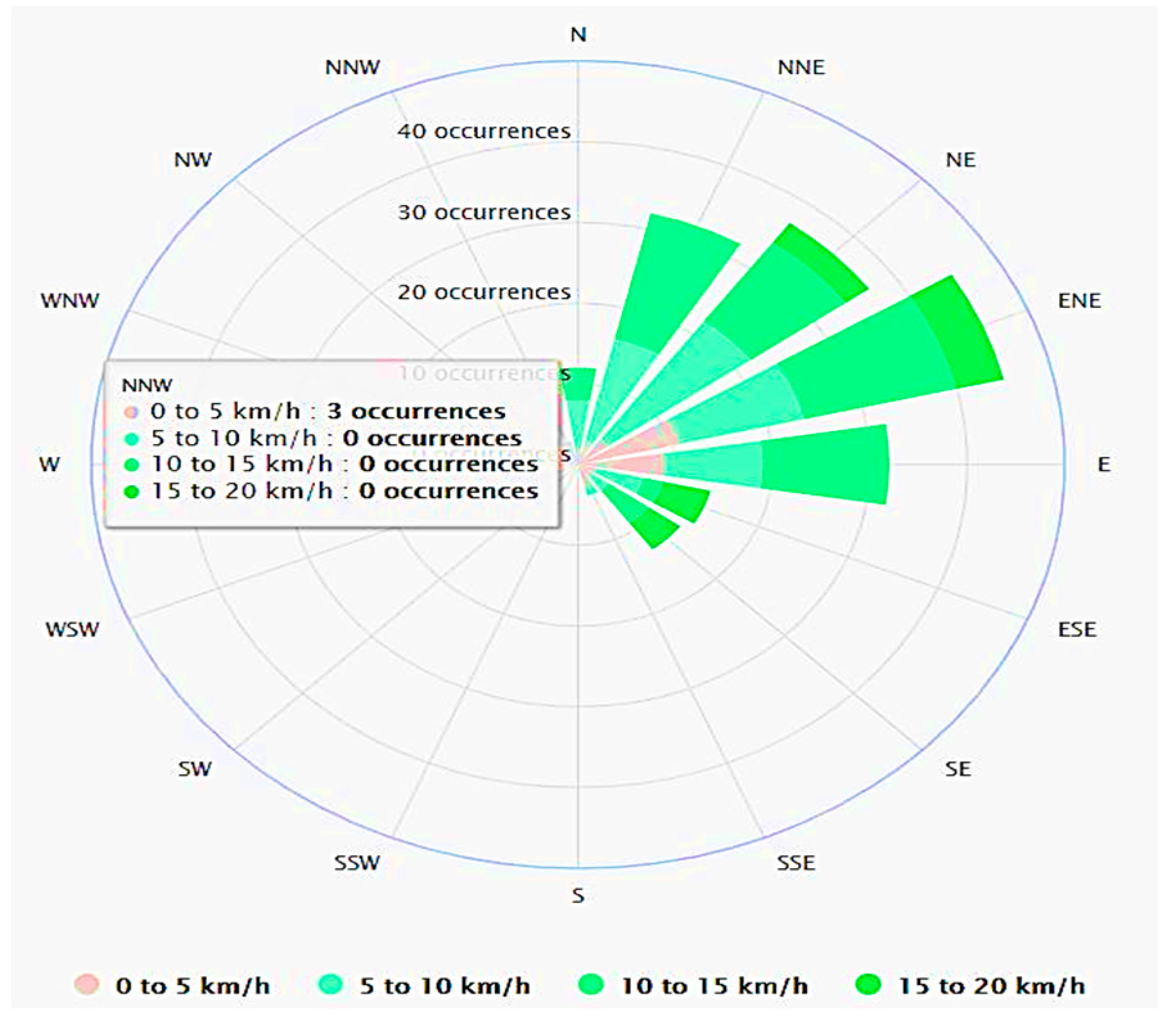

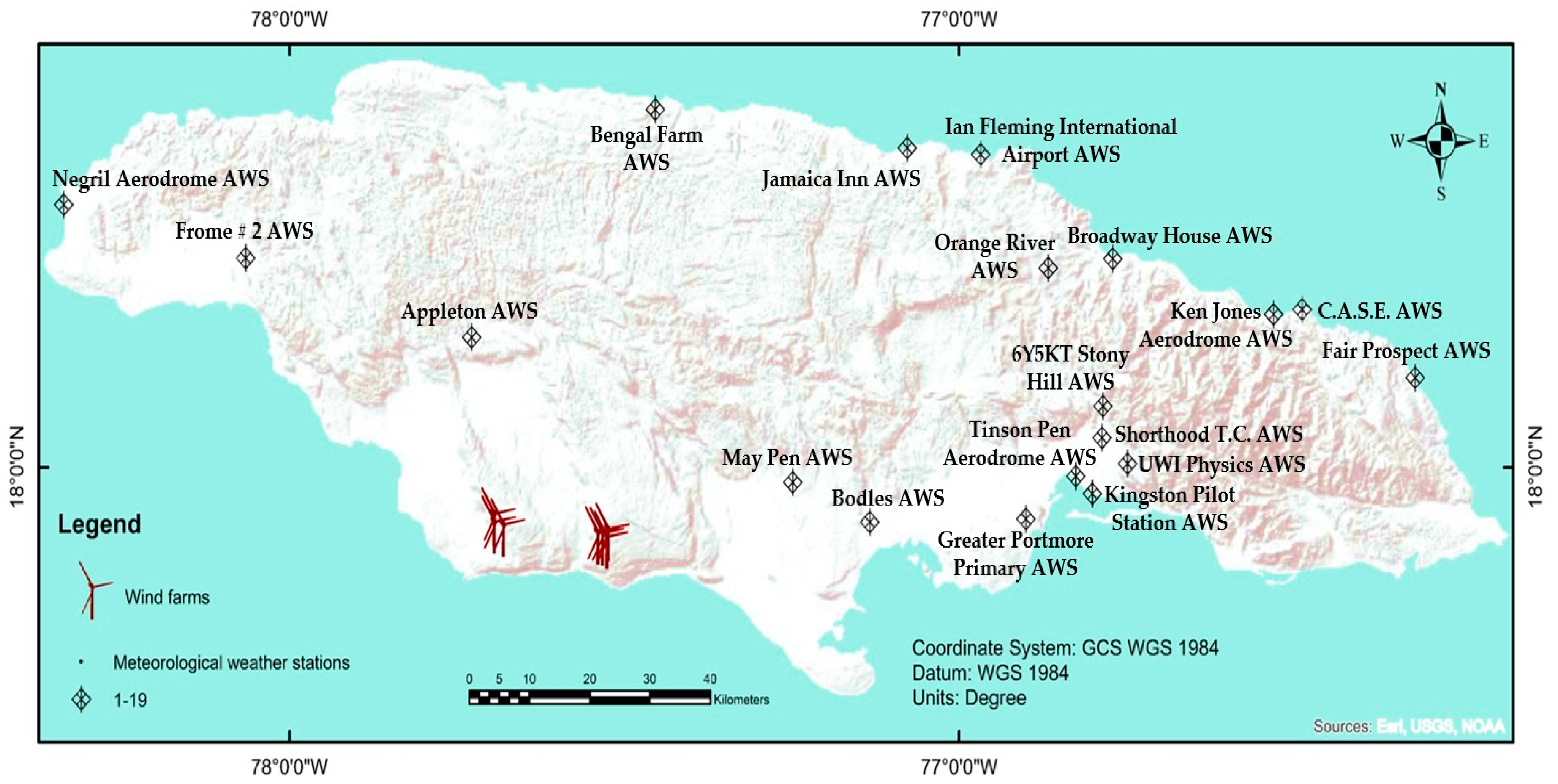

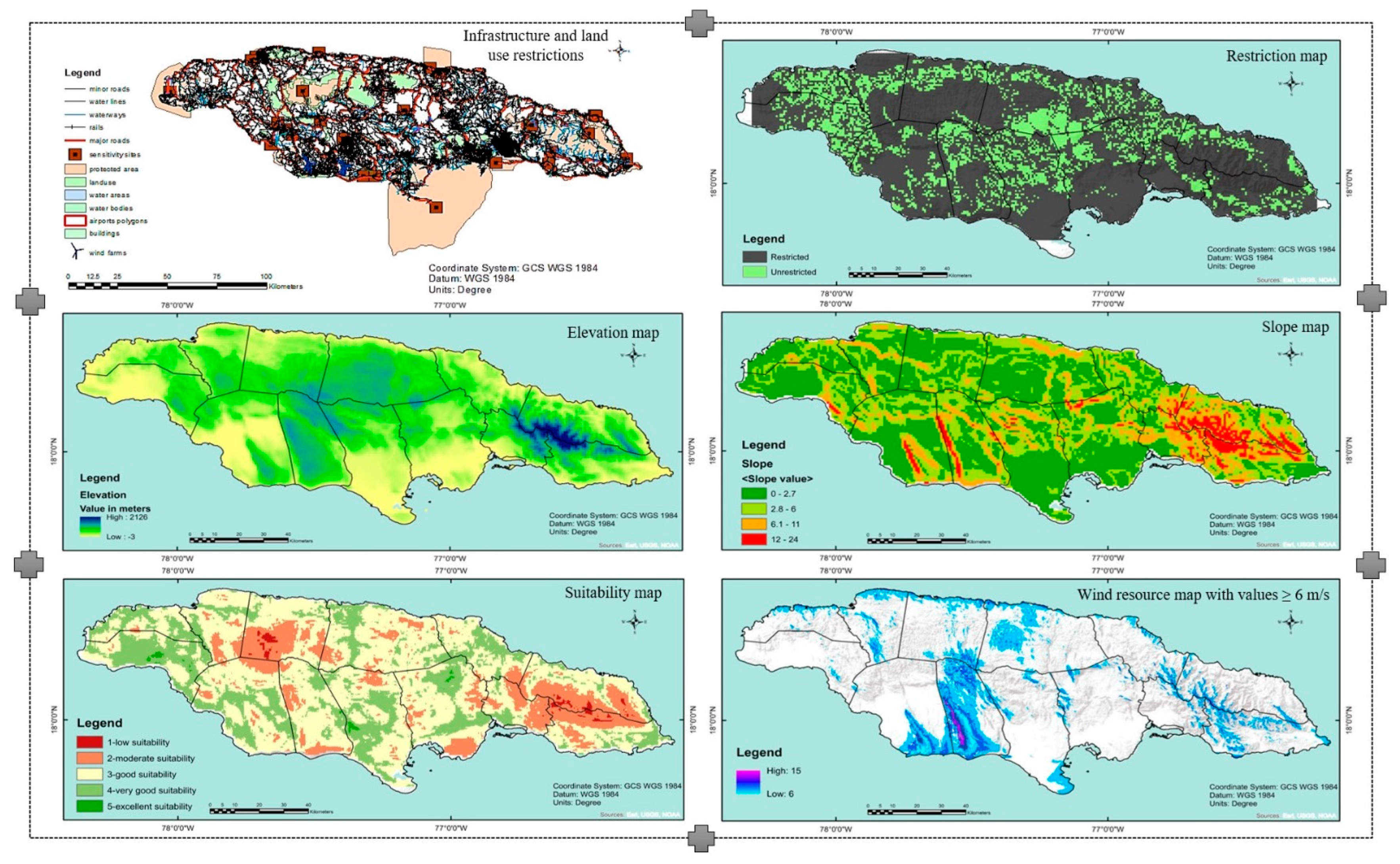
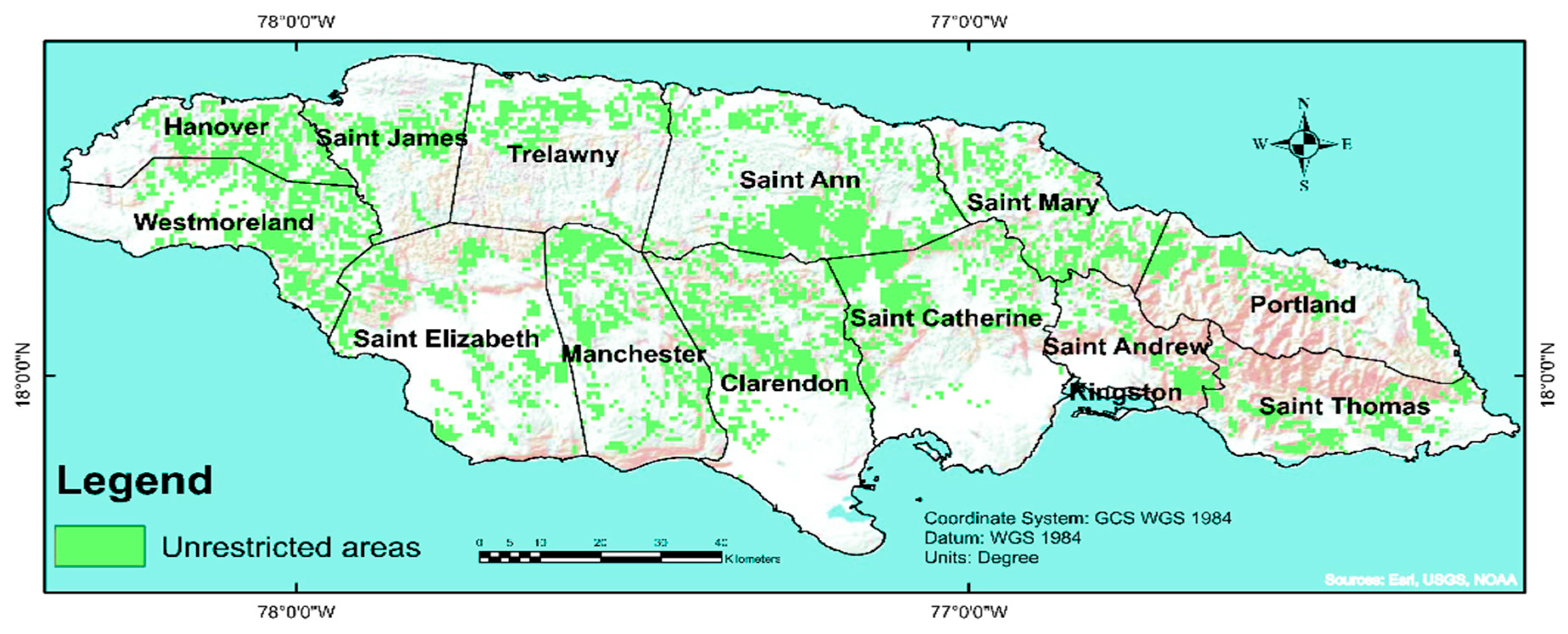


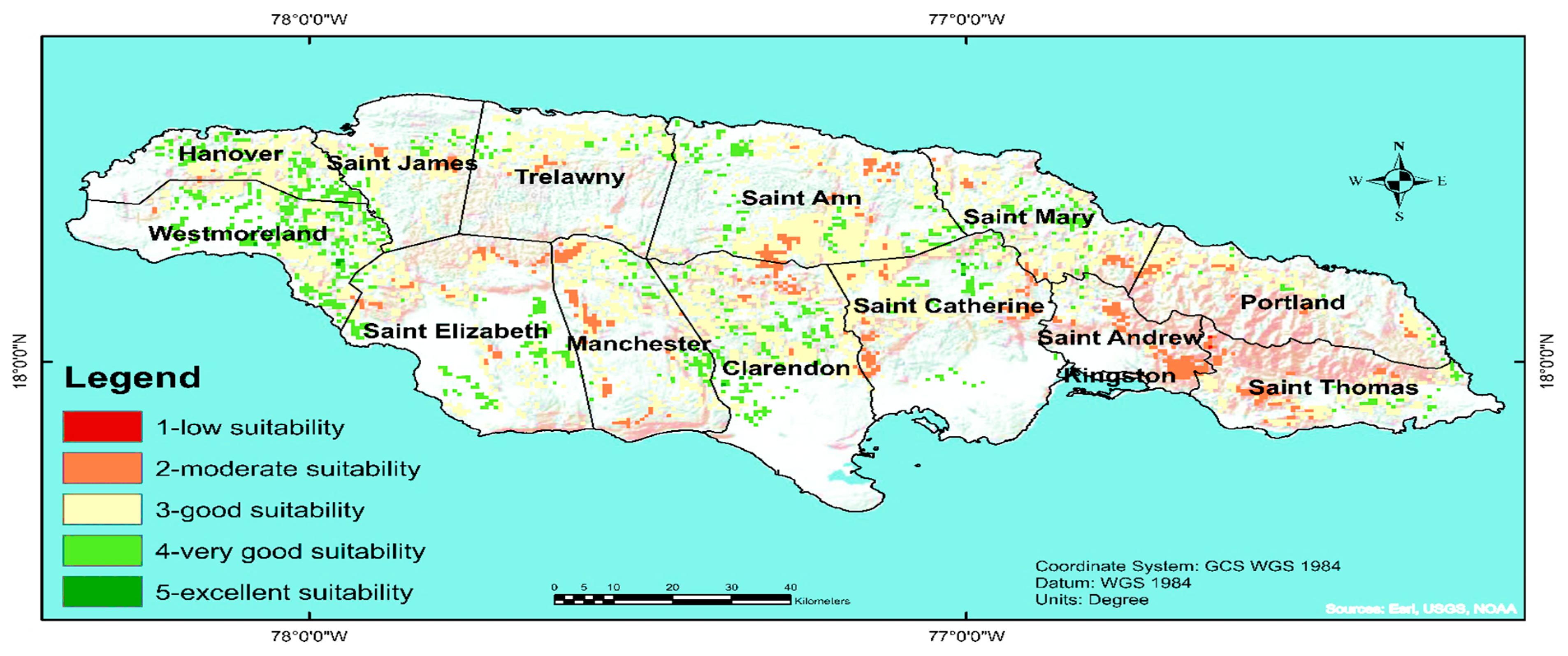
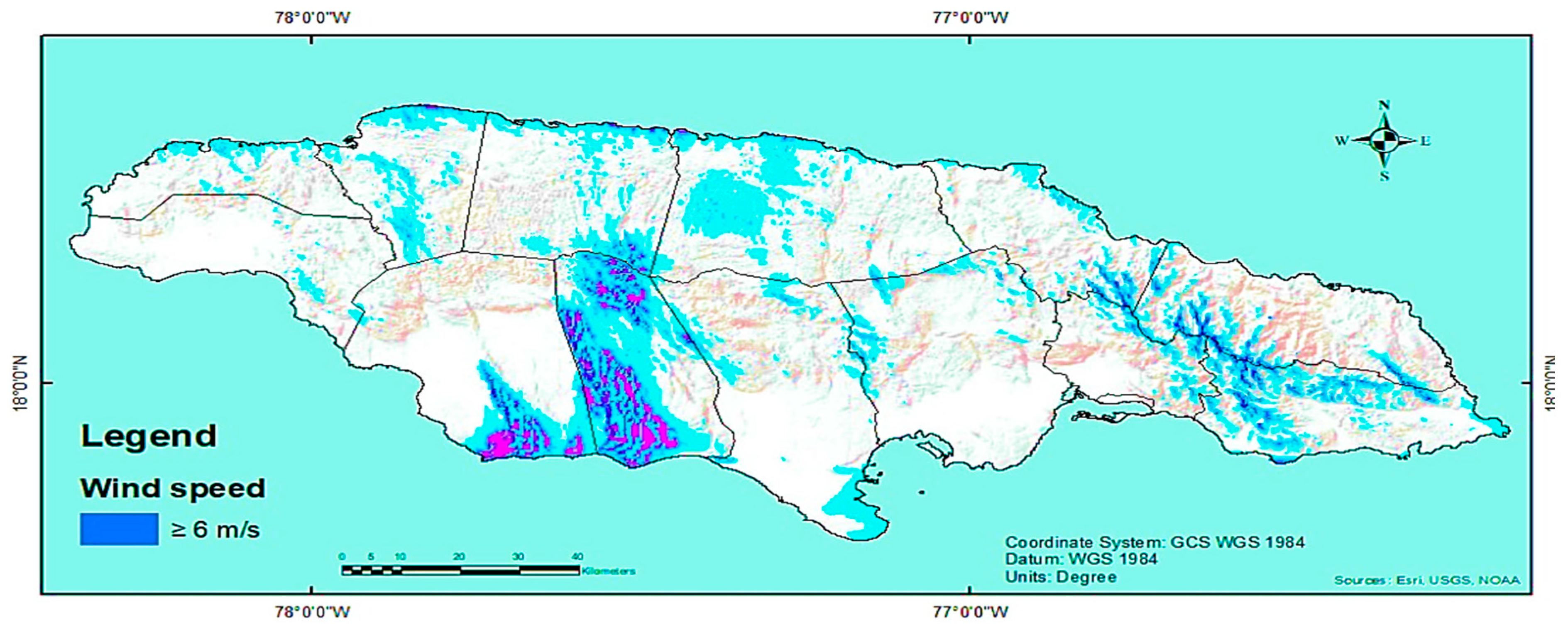

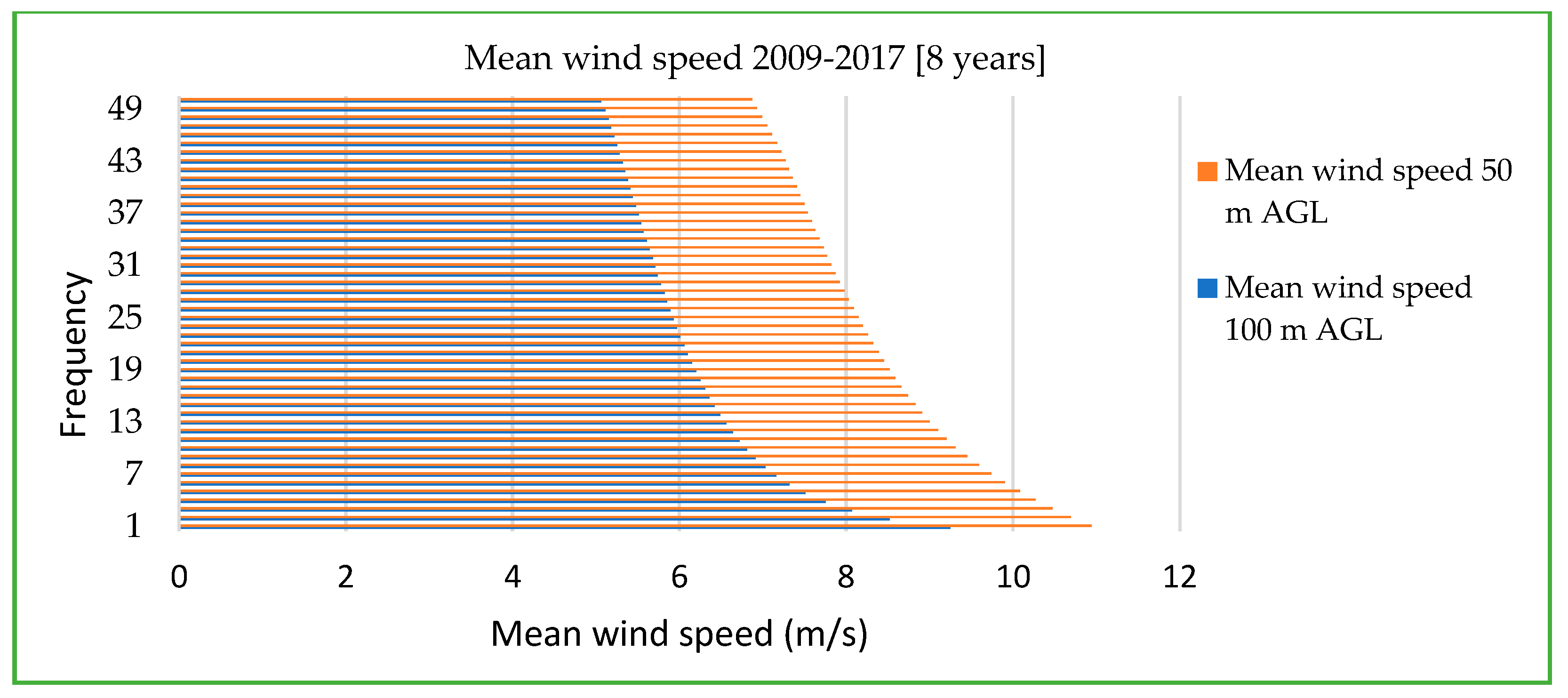
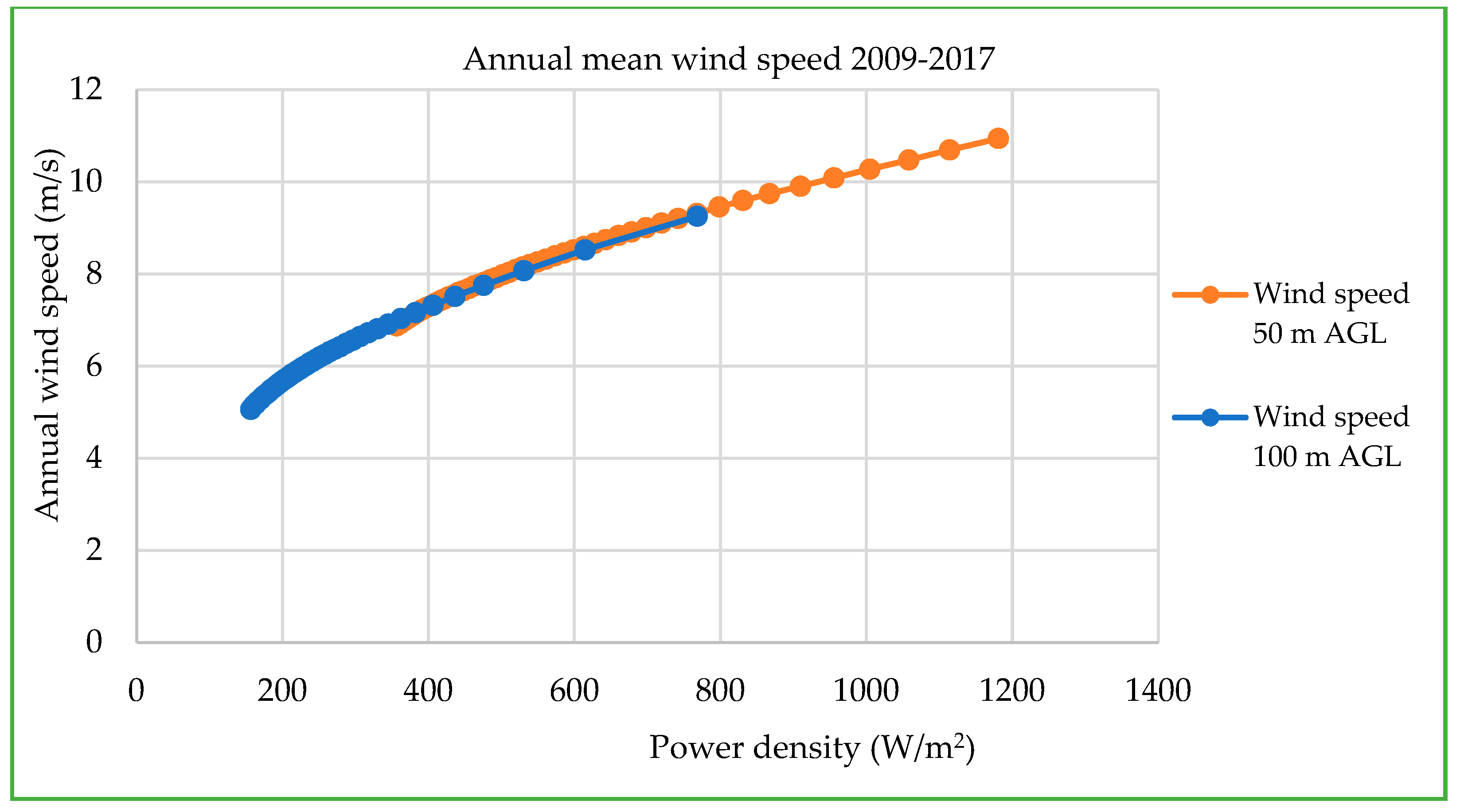
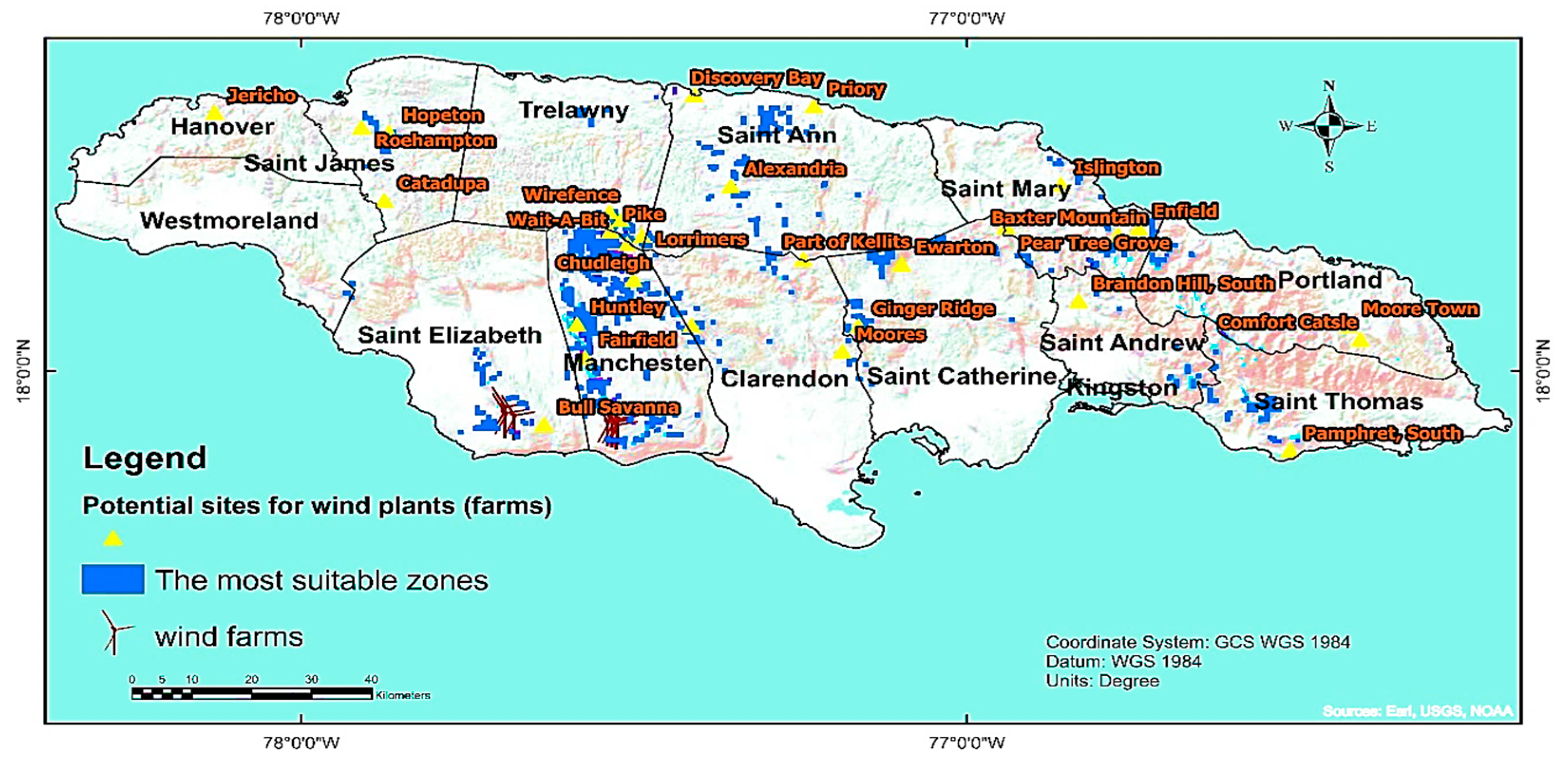
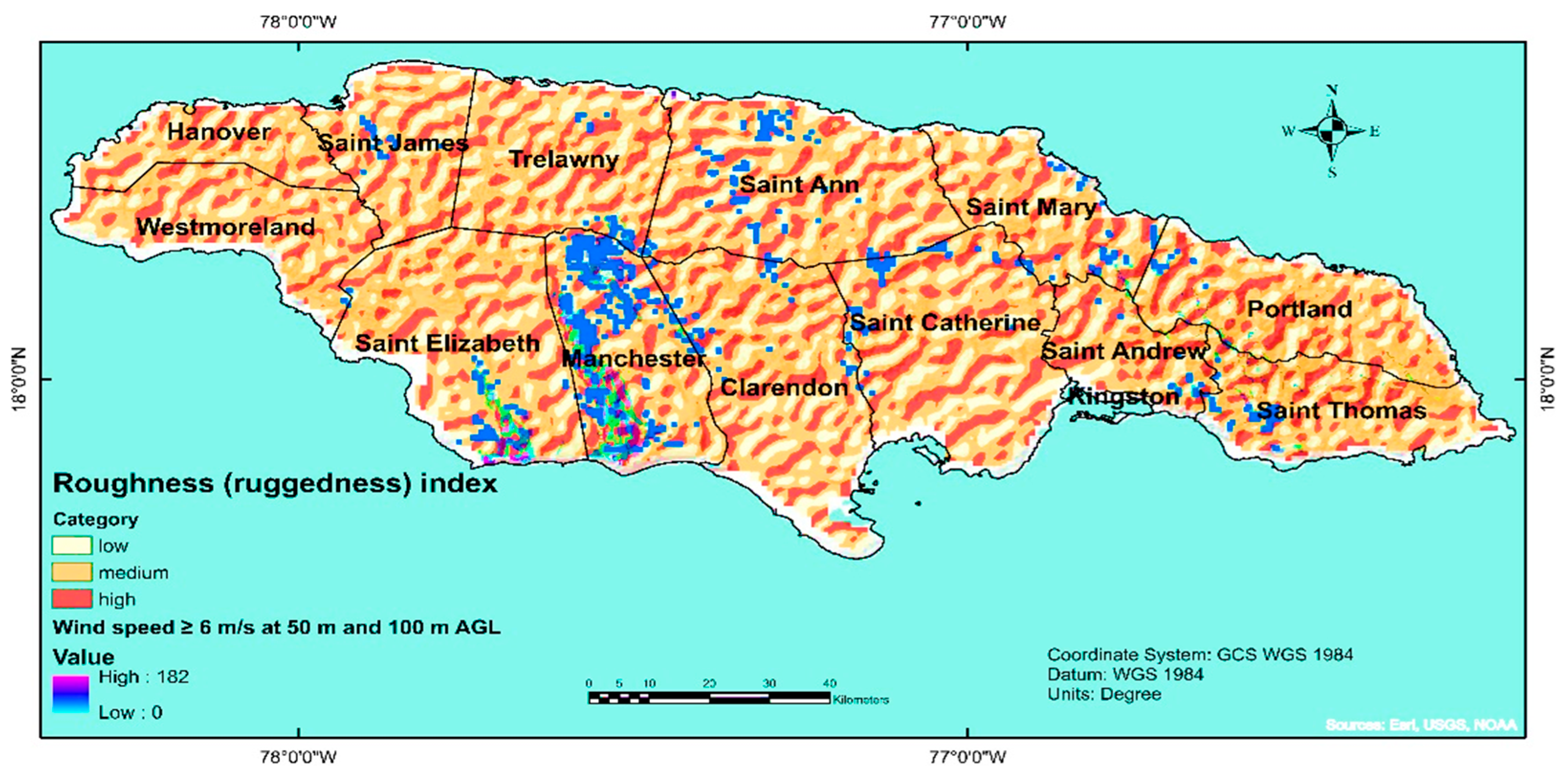
| Name (Windfarm) | Total Nominal Power (kW) No. of Turbines | Hub Height (m) | WP Type (OWF */OnWF *) |
|---|---|---|---|
| Munro Wind Farm | 3000 4 | 50 | OnWF |
| Munro College | 255 1 | 50 | OnWF |
| Malvern | 36,300 11 | No data (-) | OnWF |
| Wigton I | 20,700 23 | 50 | OnWF |
| Wigton II | 18,000 9 | - | OnWF |
| Wigton III | 24,000 12 | - | OnWF |
| Petroleum Corporation of Jamaica (PCJ) | Suitability study on the way | - | OWF |
| Study Criteria | Variable | Measurements (m), (%), (MW), and (Numbers) | Parameter, References A–H | |||||||||
|---|---|---|---|---|---|---|---|---|---|---|---|---|
| This Study | Global Wind Atlas (GWA) [18] | von Krauland et al. (2021) [26] | Basheer et al. (2017) [27] | Watson and Hudson. (2015) [28] | Enevoldsen and Permien. (2018) [29] | Sliz-Szklin and Joachim. (2011) [30] | Jamaica’s Environment and Planning Agency [31] | Cevallos and Martine. (2018) [32] | Raw count | |||
| Factor variables (FV) for suitability model | Visibility impact | 2000–4000 m | o | x | x | o | o | x | x | - | o | 4 |
| Slope | 10–30% | o | o | x | o | o | x | o | - | o | 6 | |
| Resource potential | Varies (MW) | o | o | x | x | o | o | - | o | 5 | ||
| Distance Transmission line | <2000 m | o | x | x | x | x | o | x | - | o | 3 | |
| Land cover (terrain roughness) | Low to high | o | o | x | x | x | x | o | - | o | 4 | |
| Resource Frequency (WS) | Varies | o | o | x | o | o | o | o | - | o | 7 | |
| Population density | varies | x | x | o | x | x | x | x | - | x | 1 | |
| Wind turbine | varies | o | o | o | x | x | x | o | - | x | 4 | |
| Orography feature | - | o | o | o | x | x | x | x | - | x | 3 | |
| Elevation | >30 | o | o | x | x | x | x | o | - | o | 4 | |
| Wildlife distance | <1000 m | o | x | x | o | x | x | x | - | x | 2 | |
| Weibull distribution | - | o | o | x | x | x | x | o | - | x | 3 | |
| Building | 1–1500 m | x | x | o | o | o | x | o | o | x | 5 | |
| Airport | >1500 m | o | x | x | x | x | o | x | o | x | 3 | |
| Road | 100–10,000 m | o | x | o | o | o | o | o | o | x | 7 | |
| Railway | 200–500 m | o | x | o | x | o | x | o | - | x | 4 | |
| Waterway | 170–200 m | o | x | o | x | x | x | x | - | x | 2 | |
| Waterbody | 0–200 m | o | x | o | x | x | x | x | - | x | 2 | |
| Land use | 200–10,000 m | o | x | x | o | o | o | x | - | o | 5 | |
| Special site | 1000–10,000 m | o | x | x | o | o | x | o | x | x | 4 | |
| Protected area | 200–2000 m | o | x | x | o | o | x | o | x | x | 4 | |
| Existing wind farm | 170 m | o | x | o | x | x | x | x | - | x | 2 | |
| Characterization of Factor Variables (Restriction and Suitability Criteria) | Factor Variables in the Suitability Model | Buffered Zone (Meters (m)) | Description | Source |
|---|---|---|---|---|
| Economic | Roads: major and minor | 500 m | Major roads comprise highways, while minor roads are streets, lanes, alleyways, and trails. Practically, the building and maintenance of RE plants require physical access by road, railway, and waterway, which leads to the sites’ main entrances. The road around the perimeter is also necessary for infrastructural development, with internal roads for access to the substation, transmission boxes, and inverters. Conversely, delineated distances need to be applied between all roads in case of accidents from wind turbine malfunction, such as falling debris–blades. The recommended buffer distance varies from 170 m to 3000 m. | von Krauland, 2021 [26]; Baseer et al., 2017 [27]; and Zahedi et al., 2022 [33] |
| Economic | Railway | 500 m | Like roads, railways provide access for installation plus continued maintenance. Nevertheless, to avoid damage to persons and properties from falling debris in time of turbine dislocation; therefore, it is recommended to install wind turbines at a specific distance from moving rails. | Zahedi et al., 2022 [26]; Watson and Hudson, 2015 [28]; Enevoldsenand Permien, 2018 [29] |
| Economic | Transmission lines | Nearby proximity of wind farms to the electricity grid is recommended to reduce the cost associated with installing and repairing transmission cables. The national electricity grid map in the study is created with data through provisional permission obtained from the Jamaica Public Service website, the largest electricity distributor on the island of Jamaica [34]. | Baseer et al., 2017 [27] | |
| Environmental | Sensitivity sites and protected areas | 1000 m | Sensitivity sites include places designated as nationally significant because of their great historical value and outstanding national beauty. Building on these sites poses opposition while encroaching on the scenic quality of areas, potentially leading to natural and cultural degradation. Likewise, areas designated as protected sites are within boundaries of special access by law since they are nationally and internationally recognized as defined geographical spaces, dedicated and managed by legal means to achieve long-term consideration of ecosystem services and cultural values. They incorporate bird sanctuaries, the Blue and John Crow Mountains, Royal Palm Reserve, the Black River Morass, and Palisadoes– Port Royal Protected Area, among others. In addition, 1000 m is used as a buffer zone around these areas as deemed appropriate by Watson and Hudson, 2015 [33]. | Baseer et al., 2017 [27]; Zahedi et al., 2022 [33] |
| Social and safety | Land use | 500 m | The land use data set consists of residential and commercial properties, which are utilized since specific building shapefiles are unavailable. In addition, public parks, forests, industrial facilities, farmland cemeteries, and other used spaces are represented. Distance to wind turbines from residential and urban areas is essential for public appeal since it sometimes causes opposition. A distance of 170 m [26] to 6000 m [27] is recommended to avoid pollution, flick emissions, and aesthetic appeal. Therefore, it is crucial to define constraint areas around land use. Jamaica’s 1994 Building Code, Volume 2: Energy Efficiency Building Code Requirements and Guideline, gives no clear rules for prohibitions regarding RE systems installation [35]. Similarly, the recently developed Regional Energy Efficiency Building Code does not provide such consideration. Instead, the focus is internal—for the building’s heating, lighting, cooling, and ventilation [36]. In addition, RE facility operators are obligated to comply with environmental standards outlined by the National Environmental Planning Agency (NEPA) and the National Land Agency after obtaining specific permits. However, the list of compliance found on NEPAS’s, the national Lang Agency’s website (web address: http://nep_gov.jm (accessed on 3 January 2022) [29], and libraries exclude boundary-specific prohibitions. Nevertheless, the recommended radius restrictions of a 500 m buffer zone were applied. | Baseer et al., 2017 [27]; Zahedi et al., 2022 [33]; Watson and Hudson, 2015 [28]; National Environment and Planning Agency, Jamaica, n.d. [31]; William, R. 2017 [36] |
| Social and safety | Waterways | 200 m | Although the distance from water bodies and waterways has been considered marginal or of low importance in some wind power site suitability studies, for example, in the works of Enevoldsen and Permien, 2018 [25], von Krauland et al.; 2021 [26], and Watson and Hudson, 2015 [28]. However, these areas are restricted since building wind power stations or erecting onshore wind farms in a lake, reservoir, pond, or gully is impractical. Furthermore, installing wind power systems in lake areas would require offshore-type turbines with different thresholds, including fitting foundational structures. Therefore, a 200 m buffer distance is inputted with references from Baseer et al., 2017 [27], Sliz-Szklinarz and Vogt, 2011 [32], and Siyal et al., 2015 [37]. | Baseer, et al., 2017 [27]; and Zahedi, et al., 2022 [33] |
| Social and safety | Waterbodies | 200 m | Like waterways, water bodies are inappropriate locations for situating wind farms. Thus, such areas are restricted in this study. Moreover, installing wind power systems in water bodies would require offshore-type turbines with different thresholds, including fitting foundational structures. Therefore, a 200 m buffer distance is recorded with references from Baseer et al., 2017 [27], Sliz-Szklinarz and Vogt, 2011 [30], and Siyal et al., 2015 [37]. | Baseer et al., 2017 [27]; and Zahedi, et al., 2022 [33] |
| Social and safety | Airports | 1500 m | It is essential to consider the safe distance from airports to avoid radar signal interpretation. Therefore, a buffered length of 1500 m is utilized in the restriction as adopted in [27,30]. | Baseer et al., 2017 [27]; and Sliz-Szkliniarz and Vogt, 2011 [30] |
| Technical | Elevation | Land area 30 m above sea level | The atmospheric boundary layer has wind thresholds affected by topography and land cover. Therefore, Jamaica’s topography and land cover are included in the suitability to avoid discontinuity of wind flow and danger zones. The topographic data of the digital elevation model (DEM) utilized was obtained from THE WORLD BANK Data Catalog with Jamaica’s digital elevation model raster file comprising digital elevation of 30 m resolution. Additionally, topographic data was gathered from GWA [22], covering DEM files with a resolution of 0.1 to 1 km with surface elevation in meters, referred to as orography in WAsP terminology from The National Aeronautics and Space Administration (NASA) Shuttle Radar Topography Mission (SRTM) DEM provided as 1° by 1° tile in the WGS 1984 coordinate system with reprojected modeling at 150 m grid spacing using cubic interpopulation to correspond with an effective resolution of the SRTM data contained in raster data files from GWA [22]. Both models encompass ground elevation recorded in meters relative to mean sea level (MSL) based on the World Geodetic System (WGS) 1984 reference datum; the same reference used in ArcGIS 10.8.1 for maps created. | Global Wind Atlas [18]; Sliz-Szkliniarz and Vogt, 2011 [30]; Cevallos-Sierra and Ramos-Martin, 2018 [32] |
| Technical | Resource potential (wind speed) | Wind thresholds ≥ 6 m/s | When situating wind farms, the mean interpolated wind speed throughout the data studied is recommended. This is expressed in many wind suitability studies, including von Krauland, 2021 [26], Baseer et al., 2017 [25], Zahedi et al., 2022 [26], plus Sliz-Szkliniarz and Vogt, 2011 [30]. This study uses GWA’s interpolated wind thresholds ≥ 6 m per second and verification from local weather stations. | von Krauland, 2021 [26]; Baseer et al., 2017 [27]; Zahedi et al., 2022 [33]; and Sliz-Szkliniarz and Vogt, 2011 [30] |
| Technical | Existing wind farms | 170 m times rotor diameter | The wake effects from all existing wind farms are avoided by applying 500 m, that is, the turbulence from the wakes of neighboring turbines. However, effectively high wind speed may be decreased by wake turbulence intensity due to the closeness of wind turbines, leading to the reduced potential to generate electricity and revenues supported by the works of Cross, 2018 [3], and von Krauland, 2021 [26] and where consideration for rotor diameter is given up to 50 km with the recommendation of 170 m times rotor diameter. Consequently, in the case of Jamaica, provisions are made for rotor diameters from 27 m to 112 m since BMR-operated Malvern Wind Farm in Malvern, St. Elizabeth, operates turbines with rotor diameters of 112 m. | Cross, 2018 [3]; and von Krauland, 2021 [26] |
| Technical | Slope | Areas ≤ 10° | Some wind studies consider slopes as high sloping areas that hinder access to wind farms for installations and maintenance. Subsequently, areas with steep slopes are not considered. Wind research allows ranges from 10 to 30% or ridge crests with a threshold of 10 to 40° with a maximum correlation of 84%. The slope map is derived from the DEM file using features in the spatial analyst tool of ArcGIS. | Baseer et al., 2017 [27]; Watson and Hudson, 2015 [28]; and Rodman, 2006 [38] |
| Specific Suitable Areas with Geographic Location and Coordinates | ||||
|---|---|---|---|---|
| Location Suitability | Parish | District, Town | Latitude | Longitude |
| Location 1 | Saint Elizabeth | Bull Savanna | 17°54′27.85″ N | 77°38′7.37″ W |
| Location 2 | Manchester | Pike | 18°13′48.14″ N | 77°32′9.53″ W |
| Location 3 | Huntley | 18°4′29.86″ N | 77°35′8.25″ W | |
| Location 4 | Colleyville | 18°12′34.95″ N | 77°30′36.28″ W | |
| Location 5 | Chudleigh | 18°8′55.05″ N | 77°30′2.70″ W | |
| Location 6 | Fairfield | 18°1′11.28″ N | 77°34′25.23″ W | |
| Location 7 | Clarendon | Part of Kellits | 18°11′1.01″ N | 77°14′45.80″ W |
| Location 8 | Part of Banana Ground | 18°4′23.01″ N | 77°24′48.35″ W | |
| Location 9 | Moores | 18°1′45.67″ N | 77°11′13.76″ W | |
| Location 10 | Saint Catherine | Ginger Ridge | 18°4′20.49″ N | 77°9′45.15″ W |
| Location 11 | Ewarton | 18°10′29.07″ N | 77°5′52.32″ W | |
| Location 12 | Pear Tree Grove | 18°14′14.78″ N | 76°56′29.84″ W | |
| Location 13 | Saint Andrew | Brandon Hill, South | 18°6′50.26″ N | 76°49′55.67″ W |
| Location 14 | Saint Thomas | Pamphret, South | 17°51′51.00″ N | 76°30′52.58″ W |
| Location 15 | Comfort Castle | 18°2′58.31″ N | 76°24′32.43″ W | |
| Location 16 | Moore Town | 18°4′18.49″ N | 76°25′34.48″ W | |
| Location 17 | Saint Mary | Enfield | 18°14′5.03″ N | 76°44′29.15″ W |
| Location 18 | Islington | 18°18′28.60″ N | 76°51′31.78″ W | |
| Location 19 | Baxter Mountain | 18°13′26.22″ N | 76°46′21.17″ W | |
| Location 20 | Saint Ann | Discovery Bay | 18°27′27.09″ N | 77°24′33.48″ W |
| Location 21 | Alexandria | 18°18′19.55″ N | 77°21′15.96″ W | |
| Location 22 | Priory | 18°26′20.68″ N | 77°13′47.38″ W | |
| Location 23 | Trelawny | Wirefence | 18°15′43.75″ N | 77°32′12.67″ W |
| Location 24 | Wait-A-Bit | 18°14′58.18″ N | 77°31′11.54″ W | |
| Location 25 | Lorrimers | 18°13′20.91″ N | 77°29′16.06″ W | |
| Location 26 | Saint James | Hopeton | 18°23′42.06″ N | 77°52′5.35″ W |
| Location 27 | Catadupa | 18°16′52.86″ N | 77°52′30.83″ W | |
| Location 28 | Roehampton | 18°24′12.08″ N | 77°54′34.03″ W | |
| Location 29 | Hanover | Jericho | 18°25′39.62″ N | 78°7′48.67″ W |
| Scenario | Rotor Diameter/Spacing Horizontal Distance (m) | Area (km2) | Number of Potential Turbines | Turbine Swept Area m2 | Power Density (W/m2) | Capacity Factor (%) | Rated Capacity (kW) | Full Load Hours (h/Year) | Operating Hours (h/Year) | Turbine Power Production (kWh/Year) | Total Potential Wind Power (GWh/Year) |
|---|---|---|---|---|---|---|---|---|---|---|---|
| Scenario 1: Vestas V80 | 5.3/424 | 0.179776 | 11,937 | 5027 | 397.90 | 37.50 | 2000 | 3287 | 7487 | 6,578,151 | 62,818 |
| Scenario 2: Vestas V112 | 5.3/593.60 | 0.352360 | 6090 | 9852 | 335 | 42.90 | 3075 | 3757 | 8085 | 11,560,293 | 56,321 |
Publisher’s Note: MDPI stays neutral with regard to jurisdictional claims in published maps and institutional affiliations. |
© 2022 by the authors. Licensee MDPI, Basel, Switzerland. This article is an open access article distributed under the terms and conditions of the Creative Commons Attribution (CC BY) license (https://creativecommons.org/licenses/by/4.0/).
Share and Cite
Richards, D.; Yabar, H.; Mizunoya, T. Spatial Mapping of Jamaica’s High-Resolution Wind Atlas: An Environmental-Sociotechnical Account. Sustainability 2022, 14, 11933. https://doi.org/10.3390/su141911933
Richards D, Yabar H, Mizunoya T. Spatial Mapping of Jamaica’s High-Resolution Wind Atlas: An Environmental-Sociotechnical Account. Sustainability. 2022; 14(19):11933. https://doi.org/10.3390/su141911933
Chicago/Turabian StyleRichards, Delmaria, Helmut Yabar, and Takeshi Mizunoya. 2022. "Spatial Mapping of Jamaica’s High-Resolution Wind Atlas: An Environmental-Sociotechnical Account" Sustainability 14, no. 19: 11933. https://doi.org/10.3390/su141911933
APA StyleRichards, D., Yabar, H., & Mizunoya, T. (2022). Spatial Mapping of Jamaica’s High-Resolution Wind Atlas: An Environmental-Sociotechnical Account. Sustainability, 14(19), 11933. https://doi.org/10.3390/su141911933





